Dual roles: AFLW players working wonders in day jobs
UNDERNEATH the fierce athleticism and public adulation of the AFLW is a stark reality not faced by other elite athletes — these women still have to get up and go to work.
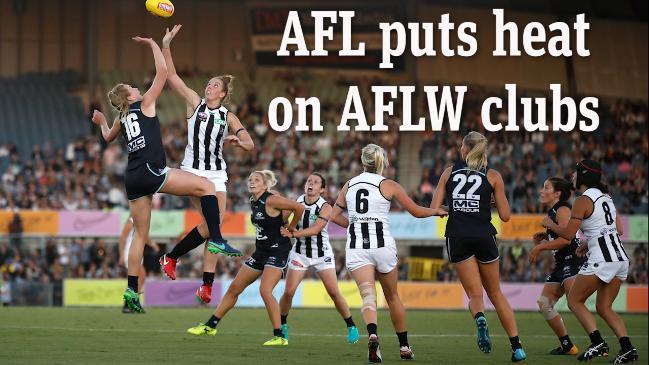
VIC News
Don't miss out on the headlines from VIC News. Followed categories will be added to My News.
WHEN the second season of the AFLW kicked off last month, the nation was again enthralled. But underneath the fierce athleticism and public adulation is a stark reality: the players still have to get up and go to work on Monday mornings.
Each week during the seven-round AFLW season, a motley crew of cops, teachers, nurses and naturopaths adjusts to life on the fringe of professional sport, with midwives moonlighting as midfielders, graphic designers becoming goalkickers and landscapers swapping khaki overalls for footy shorts.
COULD THIS BE AFLW’S BEST FORWARD COMBO?
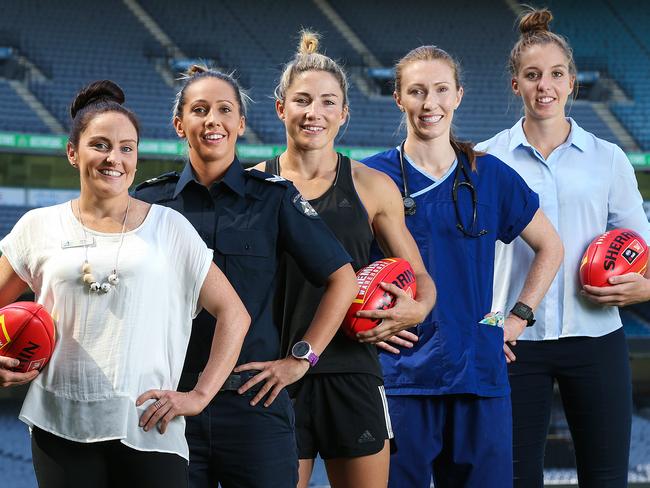
COMPLETE GUIDE TO AFLW SEASON ROUND 5
With their calendars crammed with concurrent commitments, AFLW players’ ability to keep multiple plates in the air at once rivals a dazzling circus troupe. And while there are times a plate might wobble or even shatter, mastering the balancing act of on-field success without sidelining off-field obligations is the reality of realising their football dreams.
Because while their on-field performances and discipline would have you believe otherwise, AFLW players are still considered “semi-professional”, an expression used solely in a descriptive rather than pejorative sense.
It simply means that without an extravagant pay cheque, on top of their rigorous training schedules and game-day commitments, they also juggle employment or education.
Without significant remuneration to buy their commitment, passion alone drives their pursuit of game-day glory; dedication drags them out of bed at 5am after a full day of competition; camaraderie keeps them in the gym with exam study on their mind; and pure grit and determination inspire them to front up at training after an exhausting day at work.
FUTURE OF FOOTY: AFLW BOSS NICOLE LIVINGSTON HAS EYE ON THE BALL
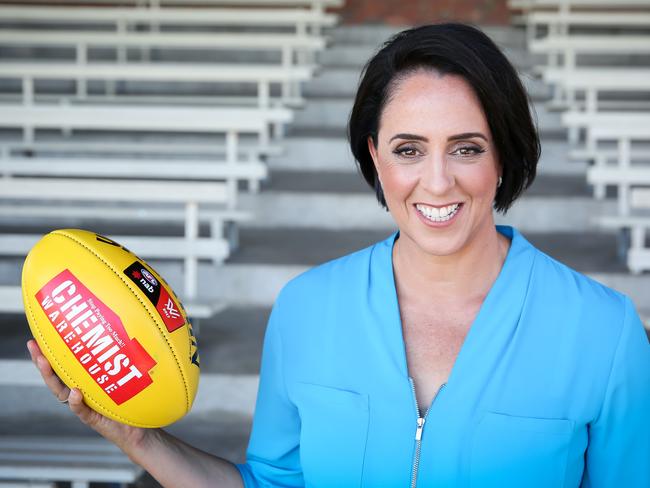
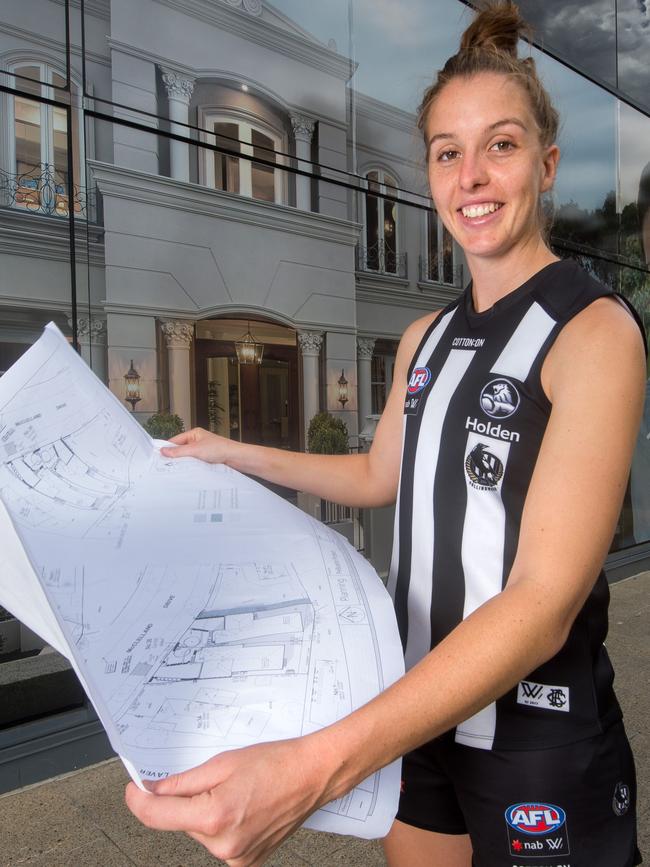
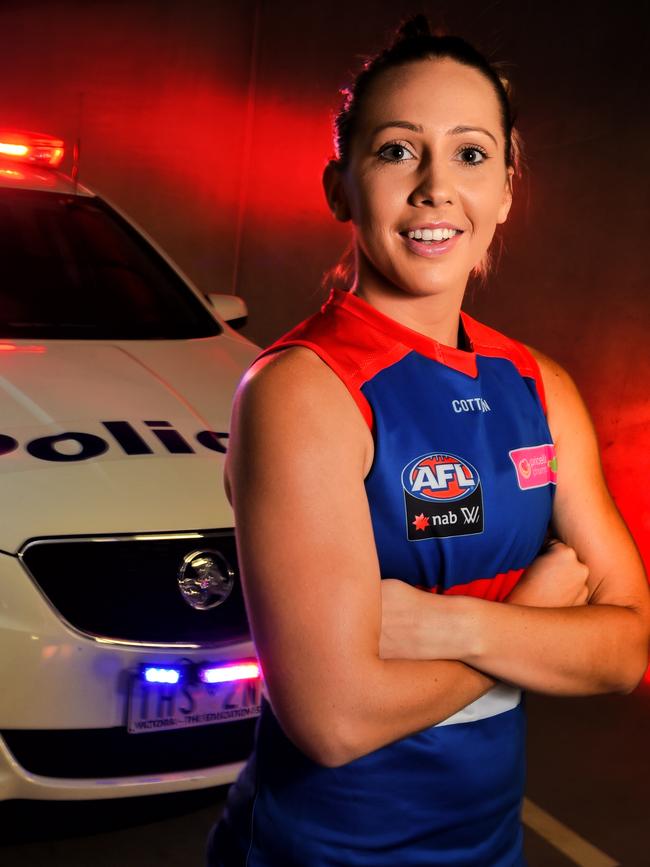
AFLW SHOW HOSTED BY A MAN? WELCOME TO WOMEN’S FOOTY ON NINE
It’s a contrast to the life of an AFL player, with some commentators noting it harks back to the men’s league’s less commercial, humble past, when Kevin Sheedy was a back-pocket plumber, Syd Jackson a tradie and Rene Kink a hairdresser at Kinky Cuts.
And while the AFLW’s new head of football, Nicole Livingstone, says the league will evolve, she is wary of losing the unique nature of the game that allows these elite athletes to have their metaphorical cake and eat it too, while creating a new generation of role models.
“We will, in time, get to the point where the league is commercially viable and there are sponsorship deals in place, but at the heart of it, the girls are doing it because they love it,” Livingstone says.
“The window of opportunity is small as an athlete, and particularly for athletes in contact sport, so to put all your eggs in one basket is really dangerous. I really like the fact that our players come from such an eclectic mix of backgrounds.
“I was in the car with my 15-year-old daughter and her friend and they were talking about one of the teachers at school and how she is playing AFLW. The girls were saying how amazing it was — like she is putting on this superwoman cape at the weekend.
“I love the fact that they are professional in terms of having other vocational aspirations.
I don’t ever want to lose that, I think it’s really important that the players are all well-rounded.”
FEMALE FOOTY BOOM LEADS TO VICTORIAN OVALS SHORTAGE
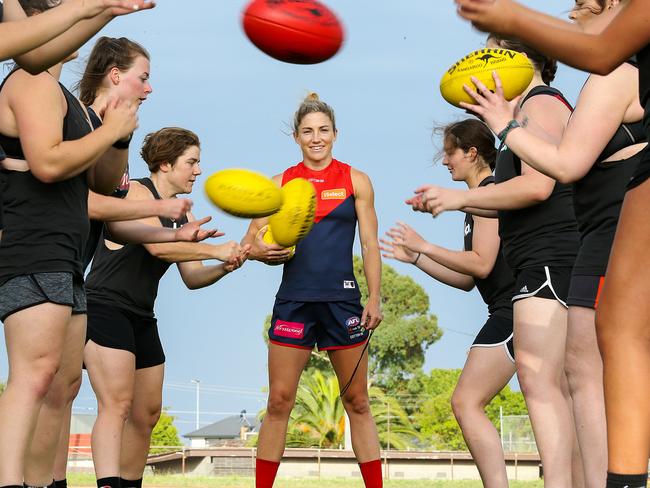
It’s a sentiment echoed by other players.
“I am grateful for the opportunity to do both,” doctor and Bulldogs ruckwoman Tiarna Ernst says. “We have become trailblazers and role models to young girls and I think it sets us apart from the male game.”
Footy coach, mentor and Melbourne star Melissa Hickey agrees, saying, “We have seen in the past that former athletes become disorientated when they retire.
“I think in some ways, coming from such diverse backgrounds, we are better prepared for real-life experience post-football. I’ve played with mental health workers, researchers, scientists, engineers, accountants, midwives, farmers and girls still studying.
“If football is taken away from us, we still do other things — it’s a real cross-section
of amazing human beings.”
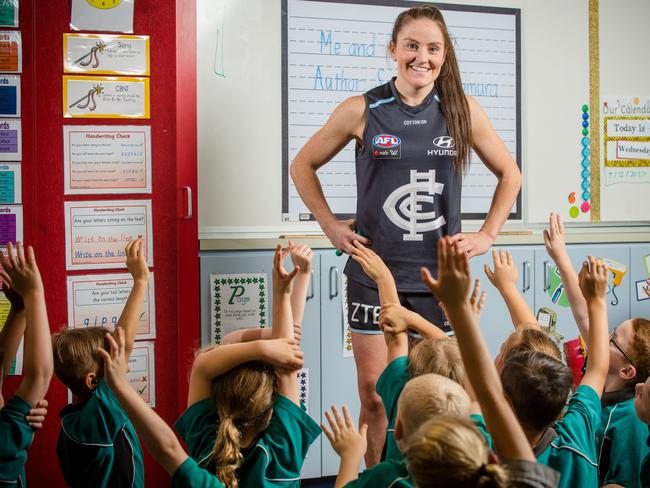
SHAE AUDLEY
Primary school teacher and Carlton midfielder
SHAE Audley, 29, learned she had been drafted to Carlton surrounded by 100 students from Laurimar Primary School, where she has been teaching for more than three years.
“We set up a big room with a TV and had about five grades of prep and grade one sitting there,” Audley says. “I don’t know if the kids really understood what was happening; I overhead one little boy leaving the room yell, ‘She won the grand final’. But they were so excited for me.”
Audley says the delicate and ambitious seesaw of footy and teaching during term one can be exhausting.
“It’s very busy; last year I didn’t realise how busy I was until it got to the end of the season and I was so under the pump to get everything done at school,” she says.
“I’m someone that likes to give 100 per cent in everything I do. But when you are physically and mentally exhausted, it can be a bit of a challenge, although I do think
as a teacher we are pretty organised.”
Audley is grateful to play in an era that hopefully won’t see the stars struggle with the transition when the game is over.
“We want people to know we can fulfil a career and be professional athletes and it doesn’t have to always come down to being a footballer first,” she says.
“Teaching is something I am really passionate about and the rewards I get from teaching are huge. When football is done, you have something to fall back on that you will equally enjoy.”
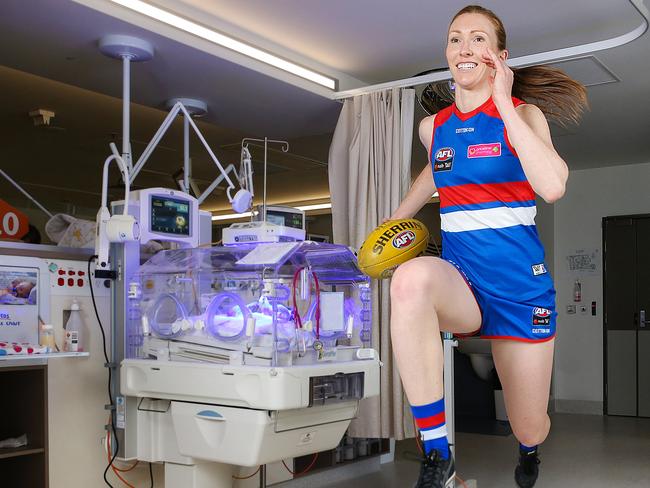
TIARNA ERNST
Doctor, specialising in obstetrics & gynaecology, and Bulldogs ruckwoman
SPECIAL K might be a new sponsor of the AFLW, but Ernst, 30, clearly eats plutonium for breakfast, such is her indestructibility.
The obstetrics and gynaecology registrar has been studying for more than 12 years, including three years in a competitive specialty program.
“I have had two of the biggest exams of my career in the last 12 months; it’s been
a pretty long road and a hard slog,” she says.
“I don’t really know what to do with myself now that I don’t study … in addition
to work and playing football.”
Incredibly, Ernst has delivered more than 600 babies during her career and admits her other life as a footballer often comes up in delivery room conversation.
“Most midwives gossip when I leave the room, usually to the husbands if they are mad Bulldogs supporters,” she jokes. “It’s exciting that people still want to talk about
it in those situations, and special for them
to say I was a part of that moment.”
But Ernst admits navigating the inaugural season, without a map or blueprint, was
an almost impossible task.
“I don’t know how I did it, looking back now, but you just make it work, I think, and go in with the idea that, ‘Well I’m just going to have to try and balance it’,” she says.
“It means shuffling rosters so I can make training in the evenings, and days when I’m not training I’m doing a nightshift. Then I sleep the next day and go to training.
“Organisational skills are very important, and also efficiency of time — even being able to eat quicker makes a difference.
“I needed a break both mentally and physically when I got to the end of last season, and I’ve approached this season with a lot more enthusiasm because I have learnt lessons of what worked last year.
“It’s tough, but I don’t think I would have my life any other way. I’m proud of this amazing story and I know when I look
back in 20 or 30 years, I probably won’t be able to believe I did all that.”
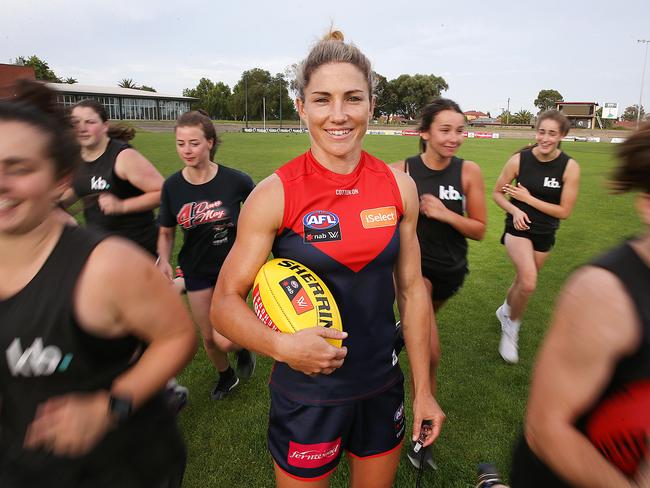
MELISSA HICKEY
Football coach, mentor and Demons defender
WOMEN fought long and hard to be treated equally and taken seriously in football, so when history caught up, Melissa Hickey, 33, wasn’t going to let anything get in her way of seizing the moment. Not even her job.
Having studied occupational therapy, Hickey says nine to five work was not feasible if she wanted to pursue her dream to play football.
“When I got offered another promotion, I just felt like I couldn’t give my all to it; it felt
a little bit inauthentic to pursue that path further when footy was my priority,” she says. “It got to a point where something had to give, so I chose to put my career to the side.
“And to be honest, what I was doing wasn’t really my passion, but I do feel like I am doing that now, working with young athletes.”
Hickey now works part-time, coaching a junior academy and running football skills and goal-setting for 8-12-year-olds, plus coaching and mentoring an adult academy.
Next month she will launch a new business focusing on the mindset of female athletes.
“I’m probably one player that is less affected by work commitments,” she says.
“There are girls who are massage therapists and physios, who, if they break a finger, can’t work for a couple of months. There are girls who get up at 6am, do the 9 to 5, drive to the city for training, get home at midnight and get up at 6am the next day. They are the real heroes.”
Hickey, one of the league’s most recognisable players, is looking forward to opportunities that will arise as the game grows, from coaching to commentary and administration. She would love to do more in the media.
But for now, the privilege of playing the game trumps everything, even a full-time wage.
“My view is that I want to be the best athlete I can be while I have this small window of opportunity. I will just have to make my money when I finish,” she laughs.
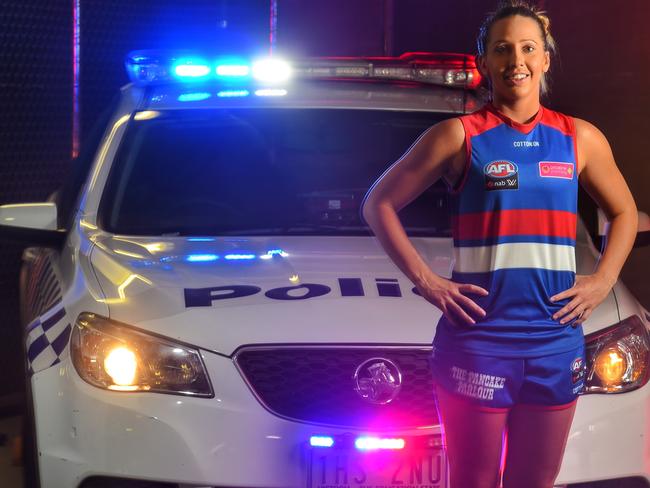
LAURA BAILEY
Policewoman and Bulldogs defender
LAURA Bailey, 25, always wanted to be a police officer. She also wanted to play football. And in a testament to multi-tasking women, she has done both.
“To be honest, I think I would hate to have to choose between the two; I love Victoria Police and the people I work with,” Bailey says. “It definitely has days where it is difficult; but I am happy to do 60-70 hours a week because I love them both.
“And I’ve said this from the start — you go to work and it’s your job, and then you go to the club and you get this new burst of energy from being in this elite environment.
“I actually get really excited towards the end of my shift, knowing that I’ll be training with the girls, and none of the girls show up
to training and complain about our jobs; we turn up to training and we focus on training.”
For Bailey, the unquantifiable gift of playing a game women can call their own requires little remuneration.
“Having a full-time job means I’m not dependant on the football for money, but I think if you asked the girls, they don’t do it for the money,” she says. “It’s never been about the money. I’ve never been paid to play a sport before, so I think it’s fantastic that we are getting that money.
“But in saying that, you play because you inspire young girls. The things that are not worth monetary value are the better things.”
Bailey joined Victoria Police in 2012 straight out of Year 12, and says playing football has been beneficial to her work in the highly stressful family violence unit.
“It’s a lot of hours and I probably have more of a need to switch off from work when
I leave just because of the stress associated with it,” she says. “But it’s also made me mentally strong on the footy field, and to be honest, I think football has actually helped my job in the respect that I’ve been fitter and had access to nutritional advice; I’ve noticed a difference at work because they work hand-in-hand.
“I’ve passed info onto my colleagues too … they look at what snacks I’m eating,” she laughs.
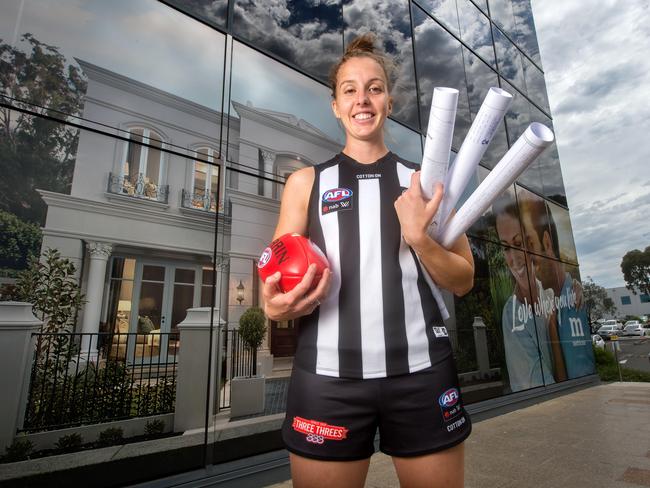
EMMA KING
Production draftsman for Metricon Homes and Collingwood ruckwoman
AT 186cm, Emma King, 23, is one of the tallest women in the competition, but she has more than one reason to walk tall.
Dreaming of playing AFL long before it was even possible, King never gave up on the hope of hearing the glorious sound of her boot thumping a Sherrin in front of a large crowd.
“I’ve been playing footy my whole life, but when I reached the age of 14 I was told, ‘It’s not quite for you any more’,” she says.
“So instead of playing against 14-year-old boys, I played in the open-age women’s competition, which didn’t have a minimum age limit, so I played against 35-year-old women. Now to get to this level and represent Collingwood … it’s a childhood dream that probably felt impossible during my teenage years.”
Having studied a bachelor of design, majoring in architecture, King hopes she is creating a level playing field for girls who follow.
“It’s definitely a juggling act; there are long days and a lack of sleep, but once you get into routine it’s OK,” she says.
“During the day I’m a ‘drafty’, which is great because it means my mind is not completely encompassed with footy and it keeps my mind fresh going into training.
“I think with the way society is these days, it’s tough enough for women to have a career and a family, let alone have a career and a family and play football.
“Women have to give up a lot and it’s great to be role models for young women and to be able to have a successful career, and a career in sport, and we can have children — three players at Fremantle are already mums.”


